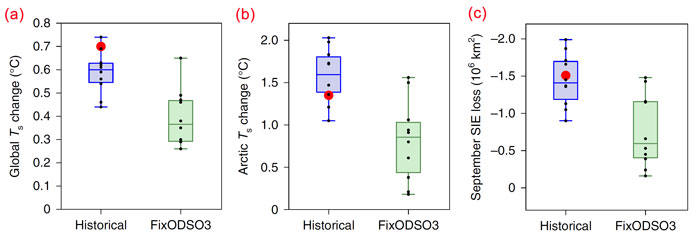| Tweet | Follow @co2science |
Paper Reviewed
Polvani, L.M., Previdi, M., England, M.R., Chiodo, G. and Smith, K.L. 2020. Substantial twentieth-century Arctic warming caused by ozone-depleting substances. Nature Climate Change 10: 130-133.
Writing as introduction to their work, Polvani et al. (2020) state that ozone-depleting substances (ODS), e.g. chlorofluorocarbons, have increased substantially in the atmosphere since the late 1950s. However, much remains to be learned about their climate impact, especially when considering ODS have radiative forcing efficiencies that are up to several thousand-fold larger than atmospheric CO2. And in this regard, Polvani et al. note that over the period 1955-2005, the radiative forcing from ODS is estimated at 0.31 W m-2, which "amounts to nearly one-third of the radiative forcing from CO2 (1.02 W m-2), making ODS, collectively, the second most important greenhouse gas in the latter half of the twentieth century." Thus, it became their objective to investigate whether some substantial fraction of climate change might be attributable to direct radiative warming from increased ODS concentrations over the period 1955-2005.
To accomplish their design, the team of five researchers analyzed ensembles of climate model integrations for this 50-year interval with (designates the historical ensemble) and without (designated FixODSO3 ensemble) ODS present as a forcing factor. The results indicated, as shown in Figure 1a below, that the global mean surface temperature increased by 0.59°C in the historical ensemble and by a smaller 0.39°C in the FixODSO3 ensemble. This led the authors to report that "in absence of increasing ODS, therefore, global warming would have been one-third smaller over that period."
A similar finding was observed when focusing on temperatures within the Arctic region (60-90°N; Figure 1b). There, average annual mean warming between 1955 and 2005 was 1.59°C when ODS were included in the model, but only 0.82°C when it was not. Consequently, Polvani et al. say that "ODS contributed almost 0.8°C to forced Arctic surface warming in the latter half of the twentieth century." Lastly, it was determined that ODS was also responsible for approximately half of the loss in September Arctic sea ice over the period 1955-2005 (see Figure 1c).
In light of the above findings, Polvani et al. say their work reveals "a substantial contribution of ODS to recent Arctic warming." If correct, it also would indicate a reduced role for atmospheric CO2. And given the recent finding of Huang et al. (2019) that climate models are presently overestimating the Arctic's warming rate by 67%, one has to wonder just how little or minimal of a role CO2 is playing in Arctic temperature.

Figure 1. The climatic impact of ODS on (a) global temperature, (b) Arctic temperature and (c) September sea ice extent over the period 1955-2005 as determined by a ten-member CAM5LE ensemble both with (labelled historical) and without (labelled FixODSO3) ODS present in the model. The boxes extend from the lower to upper quartile of the data, with a line at the median and whiskers showing the entire range across each ensemble; individual members are denoted by small black dots. Arctic temperatures are averaged for latitudes 60-90°N). Red dots denote the observed values obtained from GISTEMP27 v.3 for surface temperature and HadISST28 v.2.2.0 for sea ice. Source: Polvani et al. (2020).
Reference
Huang, J., Ou, T., Chen, D., Lun, Y. and Zhao, Z. 2019. The amplified Arctic warming in the recent decades may have been overestimated by CMIP5 models. Geophysical Research Letters 46: 13,338-12,345.




